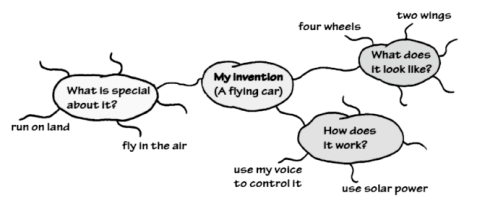五 教学过程
(一)课程导入
1.Warm-up.
T: Please guess different parts of the picture.
SS: Wheel.Light.
T: This is the wing.We call it head light.How about this one?
S1: Logo.
T: Yes.Great job.What’s this?
SS: A flying car.
T: A special and flying car.So this is our topic.You’ve already read a passage about the flying car.Today we will read the passage in your book and write a passage about the car of
the future.
课堂观察
由于写作课前布置学生做了预学案以及阅读课关于“发明”的主题内容铺垫足够丰富,大部分同学在猜词活动中比较踊跃,能准确说出“飞车”各部分的名称。
2.Check mistakes from the homework.
T: Can you find mistakes from the picture?
S1: There is a spelling mistake.It should be “P-e-t-r-o-l”.
T: How about this one? How to spell “farther”?
S2: F-A-R-T-H-E-R.It is different from “father”.
T: What does “farther” mean in Chinese?
SS:更远地。
T: I also ask you to preview the passage.Now please read it together.
课堂观察
重点解决课前学案中学生的常见错误,并邀请程度好、预学案做得不错的同学当小老师讲解,提高优生积极性。
(二)新课教学
1.Quick answers.
Ask students to close their books and answer questions about the passage to check their previewing work.
Does the flying car have wings?
How many wheels does it have?
How fast is the flying car?
How do we fly it?
What new energy does it use?
T: Questions can help us understand the passage better and questions can help us organize the writing.This is a mind-map on P60 (show it on the blackboard).

When you want to write about this topic, ask ourselves questions like “What does it look like?”
Students read the other 2 questions together.
课堂观察
教师一边提问一边将教具在黑板上拼贴成思维导图,以帮助学生认识到蛛网图对于搭建写作主体结构的重要性。但是课堂要留足够时间让学生进行头脑风暴。
2.Model passage analysis.
T: You can divide the passage into three parts.First, it tells us the topic “My invention”.What do we call the first part?
S1: Introduction.
T: Good.Next is the body part.Let’s read the introduction again.How many adjectives can you find in this paragraph?
SS: Three.“Fast.Convenient.Green”.
T: Yes.Those three adjectives can match the following three paragraphs.We can also get three key words or phrases if we want to write about other inventions.They are “appearance”“energy source” “function”.Ask yourself this following question in the last part: Why do I want to invent it? Now we have known the structure of the passage and this is the first golden rule.
课堂观察
提取关键词之后,老师可以简要穿插解释一下核心词的中文意思,再请学生齐读全文。
3.Practise analyzing passage.
T: Read the headline of the passage and tell me the advantages of this car.
SS: Smarter, Safer and more ....
T: More efficient.A new word for you.“Efficient” means do not waste energy.
T: Read the second news and find key words.Now we can get the second rule: Use adjectives to introduce your design in the beginning.
Look at the picture and think: what does it look like?
They looked more like colorful eggs than ordinary cars.Then we know Rule 3: Use different words.
课堂观察
学生扫读英文原版新闻素材,并提取标题中的关键词反应比较慢,说明教师平时要加强阅读策略的训练,才可能达到写作课读写结合的目的。
4.Make a dialogue.
Read the passage and finish different tasks for students from 2 levels on the workingsheet.Ask students to note down useful sentences for their own writing.Then make a dialogue to choose their favourite design and practise it by using the new words and patterns.________

课堂观察
两人口头训练整体比较积极,但教师应提前用清晰的指令说明:两人对话中每用到一个本堂课的新词就多给小组加一分,这样能有激励作用。
(三)课堂写作与总结
Before the writing, students use iPad to vote their favourite design and then write a passage about their favourite one in 7 minutes.
SS’ Task: Write a speech to introduce the car of the future.
Have a peer review of the writing and discuss in groups to share the best writing and share in class through iPad.
Free talk: Why should we design green and modern cars of the future?
课堂观察
学生写作时间足够,但是学生对于平板新系统的使用不够熟练,耽误了互评。教师应在课前设计小任务,让学生更懂得应用操作系统,真正发挥“互联网+教育”的功效。
